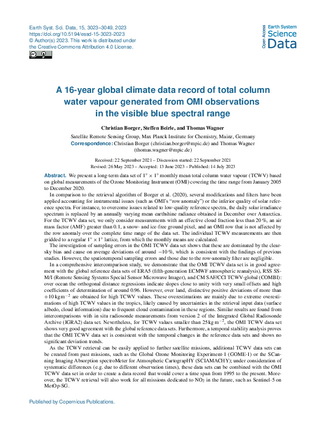Title
A 16-year global climate data record of total column water vapour generated from OMI observations in the visible blue spectral range,
Authors
Borger, C., Beirle, S., and Wagner, T.
Published
by Earth System Science Data (ESSD) at 2023-07-14
Abstract
We present a long-term data set of monthly mean total column water vapour (TCWV) based on global measurements of the Ozone Monitoring Instrument (OMI) covering the time range from January 2005 to December 2020.
In comparison to the retrieval algorithm of Borger et al. (2020), several modifications and filters have been applied accounting for instrumental issues (such as OMI's “row anomaly”) or the inferior quality of solar
reference spectra. For instance, to overcome issues related to low-quality reference spectra, the daily solar irradiance spectrum is replaced by an annually varying mean earthshine radiance obtained in December over Antarctica. For the TCWV data set, we only consider measurements with an effective cloud fraction less than 20%, an air mass factor (AMF) greater than 0.1, a snow- and ice-free ground pixel, and an OMI row that is not affected by the row anomaly over the complete time range of the data set. The individual TCWV measurements are then gridded to a regular lattice, from which the monthly means are calculated.
The investigation of sampling errors in the OMI TCWV data set shows that these are dominated by the clear-sky bias and cause on average deviations of around −10%, which is consistent with the findings of previous studies. However, the spatiotemporal sampling errors and those due to the row-anomaly filter are negligible.
In a comprehensive intercomparison study, we demonstrate that the OMI TCWV data set is in good agreement with the global reference data sets of ERA5 (fifth-generation ECMWF atmospheric reanalysis), RSS SSM/I (Remote Sensing Systems Special Sensor Microwave Imager), and CM SAF/CCI TCWV-global (COMBI): over ocean the orthogonal distance regressions indicate slopes close to unity with very small offsets and high coefficients of determination of around 0.96. However, over land, distinctive positive deviations of more than +10 kg m-2 are obtained for high TCWV values. These overestimations are mainly due to extreme overestimations of high TCWV values in the tropics, likely caused by uncertainties in the retrieval input data (surface albedo, cloud information) due to frequent cloud contamination in these regions. Similar results are found from intercomparisons with in situ radiosonde measurements from version 2 of the Integrated Global Radiosonde Archive (IGRA2) data set. Nevertheless, for TCWV values smaller than 25 kg m−2, the OMI TCWV data set shows very good agreement with the global reference data sets. Furthermore, a temporal stability analysis proves that the OMI TCWV data set is consistent with the temporal changes in the reference data sets and shows no significant deviation trends.
As the TCWV retrieval can be easily applied to further satellite missions, additional TCWV data sets can be created from past missions, such as the Global Ozone Monitoring Experiment-1 (GOME-1) or the SCanning Imaging Absorption spectroMeter for Atmospheric CartograpHY (SCIAMACHY); under consideration of systematic differences (e.g. due to different observation times), these data sets can be combined with the OMI TCWV data set in order to create a data record that would cover a time span from 1995 to the present. Moreover, the TCWV retrieval will also work for all missions dedicated to NO2 in the future, such as Sentinel-5 on MetOp-SG.
The Max Planck Institute for Chemistry (MPIC) OMI total column water vapour (TCWV) climate data record (CDR) is available at doi.org/10.5281/zenodo.7973889 (Borger et al., 2023).
Citation
Borger, C., Beirle, S., and Wagner, T.: A 16-year global climate data record of total column water vapour generated from OMI observations in the visible blue spectral range, Earth Syst. Sci. Data, 15, 3023–3049, https://doi.org/10.5194/essd-15-3023-2023, 2023.
